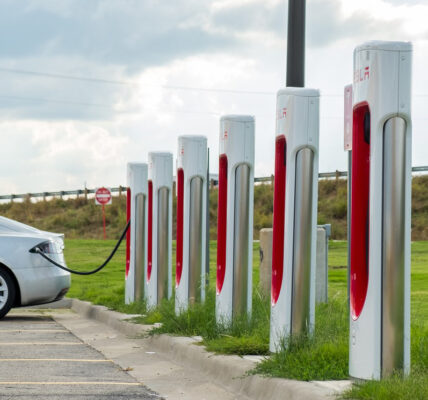General Motors Co. CEO Mary Barra says the company is in “execution mode” for its electric vehicles and again touted its plans while reporting a first-quarter profit Tuesday — the same day crosstown rival Ford Motor Co. celebrated the launch of its electric F-150.
The coinciding events gave each automaker a way to try to outshine the other. Ford is delivering the first full-size electric truck, beating GM to market by a year with its F-150 Lightning. GM’s electric Silverado comes out next year, but Barra proudly told investors pre-production of the truck will begin “in a matter of weeks” and reservations are up to 140,000.
As it works on executing its EV plans — projecting for the first time it will make $50 billion in revenue from those vehicles by 2025 — GM is still selling gas-powered products right off the truck. The Detroit automaker continues to maintain high demand despite record vehicle prices driven by low inventory amid supply chain struggles.
The automaker booked $2.9 billion in net income in the first quarter of 2021, which was only down slightly from last year’s first-quarter profit of $3 billion. Revenue from January to March was up at $36 billion from the $32.5 billion GM made in the first quarter of 2021.
Adjusted earnings before interest and taxes came in at $4 billion, around last year’s $4.4 billion. GM’s net income margin for the quarter was 8.2%. Pre-tax earnings in GM North America totaled $3.1 billion in the quarter. GM International’s pre-tax earnings were $328 million for the first quarter of this year.
“The street was bracing for an absolute disaster. And ultimately, these were better than feared,” said Dan Ives, analyst at Wedbush Securities.
The first-quarter figures and the company’s reaffirming its guidance for adjusted earnings in a range of $13 billion to $15 billion this year didn’t do much to move GM’s stock, which was down more than 4% for the day at $38.04 with U.S. markets plunging Tuesday over concerns of an economic slowdown. Ford’s stock was also down to $14.71 for a 3% drop.
GM remains focused on proving itself as a leading electric vehicle manufacturer. The automaker intends to grow to 1 million units of EV capacity in North America by the end of 2025 and is targeting production of 400,000 all-electric vehicles there this year and next year.
“We’re just going to keep executing and keep working toward our EV leadership goal,” Barra said. “We have a team that has demonstrated that we’re going to capitalize on opportunities, we’re going to solve challenges and work with our stakeholders across the company to do just that.”
GM executives believe so deeply in the mission that they are now tying their compensation to EV goals, Barra told investors.
“This is the right time to directly link a significant part of the long-term compensation for me and every other GM executive to meeting our EV goals,” she said. “Starting this year, we have added metrics for EV volumes in North America, EV launch timing and EV launch quality to our existing EBIT-margin and total shareholder return measures.”
GM releases its proxy statement detailing executive compensation on April 29.
The Detroit automaker has already launched its GMC Hummer EV pickup and Cadillac Lyriq electric crossover. By mid-2023, the automaker will also have a SUV version of the Hummer, the Silverado EV, an electric Chevrolet Blazer SS and an Equinox EV, which are all based on its new Ultium electric platform. The Chevrolet Bolt EV and EUV, which are not based on Ultium, are also back on the market after a months-long stop-sale while the automaker worked through a battery fire recall on the products.
“Right now Mary and the team are trying to get as quickly they can into 2023 because that’s where the EV story starts to take hold,” Ives said.
GM’s BrightDrop business, focused on offering electric delivery options and services, will have two electric vans: the Zevo 600 and Zevo 400. The larger Zevo 600 is in production at a supplier plant, with higher volume production slated to start in late 2022 at the CAMI plant in Ontario, with 400 production to follow in 2023.
And on Monday, GM President Mark Reuss announced an electrified Chevrolet Corvette will be available as early as next year. A fully electric version of the Corvette will also be offered.
“Investors should be encouraged that GM is playing a strategic long game despite some of the short-term frustrations presented by challenges in the supply chain,” said Jessica Caldwell, executive director of insights at Edmunds.com Inc., a vehicle information website. “GM has an exciting slew of electrified products to introduce to the market in the near future with EV variants of the Chevy Blazer, Equinox and Silverado, and now an EV version of its iconic Chevy Corvette, which puts GM in an enviable place that is almost unfathomable thinking back to its bankruptcy days.”
GM’s first-quarter results come after the automaker earlier this month reported sales of 512,846 vehicles in the first three months, down 20% from last year as slumping supply continued to limit inventory.
In 2021, automakers lost billions in potential revenue from a shortage of semiconductors or microchips found throughout vehicles from heated seats to infotainment systems. Though the semiconductor supply situation is still fluid, GM did not have to shut down plants for several months until it recently had to halt production at the Fort Wayne, Indiana, truck plant.
CFO Paul Jacobson told investors on Tuesday GM expects “to see the availability of semiconductors continuing to improve.”
Inventories on U.S. dealer lots are expected to remain tight with levels at 270,000 at the end of the quarter with much of that inventory in transit, Jacobson said. Grounded inventory was less than 15 days, he added. The low supply and high demand have led to average transaction price increases. For example, GM saw a 10% year-over-year increase on truck ATPs and 20% increase on crossovers.
“We recognize the consumer is facing inflationary pressures; however, we continue to see ongoing strong customer demand for our vehicles, including our refreshed full-size pickup trucks,” Jacobson said.
The first quarter “presented challenges for commodity and logistics costs,” but Jacobson said GM has “contractual protections in place for some commodities to help ensure supply and to provide some protection against cost volatility.”
The company also took “proactive” actions to protect its supply, he added. Specifically, GM secured supply of palladium used in catalytic converters to meet production needs this year. Experts have warned palladium supply could be a concern for automakers with the Russian invasion of Ukraine since Russia is a large supplier of the material.
“Through these actions, our commodity and logistics headwinds year-over-year came in line with our expectation at around $1 billion in Q1,” Jacobson said.
Meanwhile, GM is continuing to build up the supply of materials it will need to execute its EV plans. Last week, the automaker announced it entered into a supply agreement with MP Materials Corp. for the alloy and magnets needed for EV programs. The automaker’s first of four U.S. battery cell manufacturing plants with partner LG Energy Solution will open later this year in Lordstown, Ohio.
Ford Motor Co. reports its first-quarter earnings on Wednesday. Stellantis NV reports its revenues and shipments on May 5. The transatlantic automaker will report earnings for the first half of the year on July 26.







